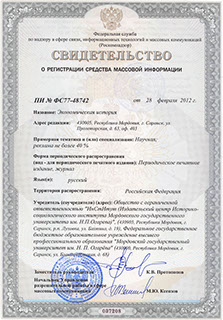Экономическая историЯ
Russian Journal of Economic History
ISSN 2409-630X (Print)
ISSN 2618-916X (Online)
Expert board:
- Scientific Council of RAS on economic history;
- Research and Educational Center «The economic history of Central Russia and the Middle Volga region» of Ogarev Mordovia State University;
- Center of Economic History of Lomonosov Moscow State University
Navigation
Certificate of registration

ISSN 2409-630X (Print), ISSN 2618-916X (Online)
DOI: 10.15507/2409-630X.054.017.202103.285-295
Sergey V. Pershin1, Evgeny D. Ekaterinin2, Alina O. Lavrushkina3
1 Scientific Research Institute of Humanitarian Sciences under the Government of the Republic of Mordovia (Saransk, Russia),
e-mail: Pers99@inbox.ru
2 Scientific Research Institute of Humanitarian Sciences under the Government of the Republic of Mordovia (Saransk, Russia),
e-mail: no.one.lives.forever@mail.ru
3 Scientific Research Institute of Humanitarian Sciences under the Government of the Republic of Mordovia (Saransk, Russia),
e-mail: agulnyashkina@yandex.ru
Labour Mobilization of the Collective Farm Peasantry Temnikovsky District of the Mordovian ASSR in the Post-War Period
Introduction and Methods. In the post-war period, the mobilization of the collective farm village and the strengthening of control over the workers began to be considered again as one of the main means of raising agriculture. The authors of the article have undertaken research on the problem of organizational and economic strengthening of collective farms in the second half of the 40s – early 50s of the XX century by analyzing the specifics of the implementation of the resolution of the Council of Ministers of the USSR and the Central Committee of the CPSU (b) of September 19, 1946 “On measures to eliminate violations of the Charter of the agricultural artel in collective farms”. The source base of the study was archival materials on the Temnikovsky district of the Mordovian ASSR. During the research, the following methods were used: comparative-historical, problem-chronological, system analysis and structural. Results and Discussion. Having received a directive from the center, responsible employees urgently began to identify violations noted in the resolution of the party and the government in the collective farms of the Temnikovsky district. Already in the autumn of 1946 as a result of the audit of the land fund, a lot of violations of the “Charter” were revealed, which consisted in unauthorized cutting of arable land to personal farms, as well as in the use of hayfields and pastures. More significant areas of land were illegally withdrawn from collective farm turnover by various institutions and organizations. The audits also revealed fictitious sections of households in order to acquire additional areas of household plots and vegetable gardens, increase the number of livestock and poultry. The reports prepared by officials based on the results of the inspections carried out indicate that the payment system, introduced even in wartime conditions, began to fail without the systematic use of repressive measures. Another characteristic feature of the development of the village in the late 1940s–early 1950s was the numerous violations of the principles of “collective farm democracy”. Conclusion. As a result of the study, the stages of implementation of the resolution of September 19, 1946, the nature and effectiveness of the event were determined.
Keywords: peasantry, collective farm, personal subsidiary farm, the Charter of the agricultural artel.
For citation: Pershin S. V., Ekaterinin E. D., Lavrushkina A. O. Labor mobilization of the collective farm peasantry Temnikovsky district of the Mordovian ASSR in the post-war period. Ekonomicheskaya istoriya = Russian Journal of Economic History. 2021; 17(3): 285–295. (In Russ.). DOI: 10.15507/2409-630X.054.017.202103.285-295.
© Ogarev Mordovia State University. History and Sociology Institute, 2017
68, Of. 411, Bolshevistskaya St., 430005, The editorial office of the scholarly journal «Russian Journal of Economic History»
Tel.: (8342) 24-25-90; 27-07-11, Fax: (8342) 24-25-90, E-mail: jurnal-econom-hist@isi.mrsu.ru
Designed by A. Napalkov, Email: napalkov@isi.mrsu.ru

